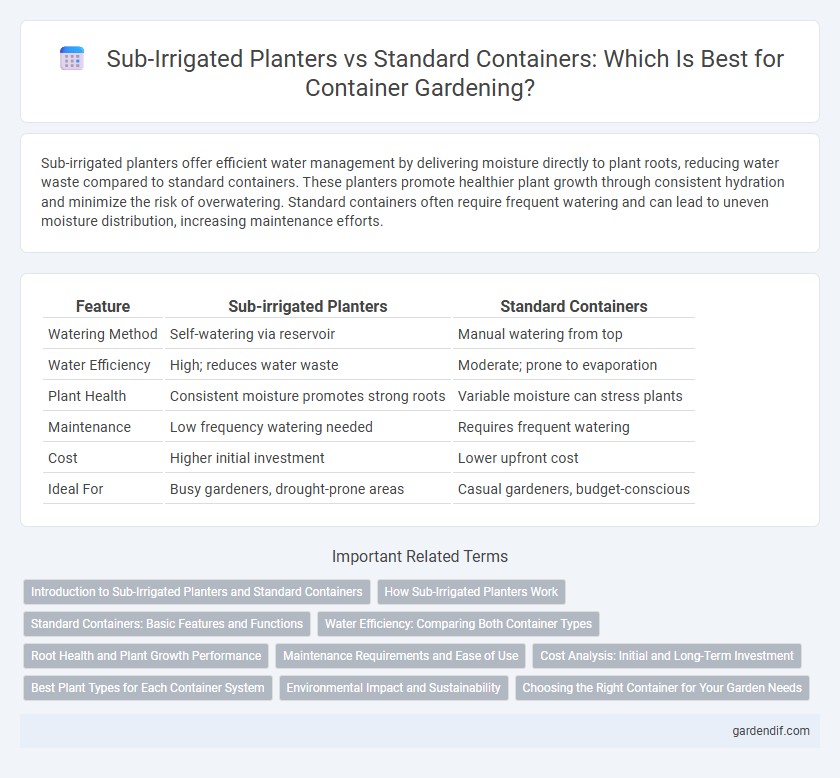
Sub-irrigated planters vs Standard containers Illustration
Sub-irrigated planters offer efficient water management by delivering moisture directly to plant roots, reducing water waste compared to standard containers. These planters promote healthier plant growth through consistent hydration and minimize the risk of overwatering. Standard containers often require frequent watering and can lead to uneven moisture distribution, increasing maintenance efforts.
Table of Comparison
| Feature | Sub-irrigated Planters | Standard Containers |
|---|---|---|
| Watering Method | Self-watering via reservoir | Manual watering from top |
| Water Efficiency | High; reduces water waste | Moderate; prone to evaporation |
| Plant Health | Consistent moisture promotes strong roots | Variable moisture can stress plants |
| Maintenance | Low frequency watering needed | Requires frequent watering |
| Cost | Higher initial investment | Lower upfront cost |
| Ideal For | Busy gardeners, drought-prone areas | Casual gardeners, budget-conscious |
Introduction to Sub-Irrigated Planters and Standard Containers
Sub-irrigated planters (SIPs) use a self-watering system that draws water from a reservoir at the container's base, delivering moisture directly to plant roots and reducing water waste. Standard containers rely on top watering, which often leads to uneven moisture distribution and increased evaporation. SIPs enhance plant health by maintaining consistent soil moisture, while traditional containers require frequent manual watering to prevent drying out.
How Sub-Irrigated Planters Work
Sub-irrigated planters work by utilizing a built-in water reservoir below the planting medium, allowing plants to draw water from the roots upward through capillary action. This system reduces water waste and ensures consistent moisture levels, promoting healthier root growth compared to standard containers that rely on surface watering. By minimizing evaporation and overwatering, sub-irrigated planters provide efficient hydration tailored to plant needs.
Standard Containers: Basic Features and Functions
Standard containers are typically made from plastic, clay, or ceramic, offering durability and affordability for various gardening needs. They feature drainage holes to prevent waterlogging and promote healthy root development by allowing excess water to escape. Standard containers support a wide range of plants but require frequent watering compared to sub-irrigated planters.
Water Efficiency: Comparing Both Container Types
Sub-irrigated planters enhance water efficiency by delivering moisture directly to plant roots through a built-in reservoir, reducing evaporation and runoff compared to standard containers. Standard containers often rely on surface watering, which can lead to significant water loss and uneven soil moisture distribution. Studies show sub-irrigated planters can reduce water usage by up to 50% while promoting healthier root development and sustainable gardening practices.
Root Health and Plant Growth Performance
Sub-irrigated planters promote superior root health by maintaining consistent moisture levels, reducing root rot and stress compared to standard containers that often suffer from uneven watering and drying cycles. This consistent hydration supports enhanced plant growth performance, resulting in higher yields and more vigorous development. Root systems in sub-irrigated planters grow deeper and more robust, optimizing nutrient uptake and overall plant vitality.
Maintenance Requirements and Ease of Use
Sub-irrigated planters reduce watering frequency through an integrated reservoir, significantly lowering maintenance requirements compared to standard containers that demand regular manual watering. The self-wicking system in sub-irrigated planters promotes consistent moisture levels, minimizing plant stress and simplifying care routines. Standard containers often require frequent checking and adjustments for drainage and soil moisture, increasing time and effort for maintenance.
Cost Analysis: Initial and Long-Term Investment
Sub-irrigated planters generally require a higher initial investment due to built-in water reservoirs and specialized materials, costing approximately 20-40% more than standard containers. Long-term savings emerge from reduced water usage and lower maintenance needs, potentially cutting irrigation costs by up to 50% annually. Standard containers have a lower upfront cost but may incur higher ongoing expenses related to frequent watering and soil replacement.
Best Plant Types for Each Container System
Sub-irrigated planters are ideal for moisture-loving plants such as herbs, leafy greens, and vegetables that require consistent hydration for optimal growth. Standard containers suit drought-tolerant plants like succulents, cacti, and lavender, which prefer well-drained soil and less frequent watering. Choosing the right plant type based on container irrigation helps maximize growth efficiency and reduces water stress.
Environmental Impact and Sustainability
Sub-irrigated planters reduce water waste by recycling excess water through a self-watering reservoir, leading to significant water conservation compared to standard containers. Standard containers often result in higher water runoff and nutrient leaching, increasing environmental strain and soil degradation. Using sub-irrigated planters promotes sustainable gardening practices by minimizing resource consumption and reducing the need for frequent watering.
Choosing the Right Container for Your Garden Needs
Sub-irrigated planters use a built-in reservoir to provide consistent water to plants, reducing watering frequency and promoting healthier root systems, making them ideal for water-efficient gardening. Standard containers offer versatility with various sizes and materials, but require more frequent watering and monitoring to prevent over- or underwatering. Selecting between these containers depends on plant species, maintenance preferences, and water conservation goals to optimize garden growth and sustainability.
Sub-irrigated planters vs Standard containers Infographic

 gardendif.com
gardendif.com